Site Menu:
| This is an archived Horseadvice.com Discussion. The parent article and menus are available on the navigation menu below: |
| HorseAdvice.com » Horse Care » Hoof Care, Hoof Trimming, Shoeing Horses » The 4 Point or Natural Trim » |
| Discussion on Sole callouses | |
| Author | Message |
| Member: cheryl |
Posted on Thursday, Dec 17, 2009 - 8:49 am: I couldn't type on Diane's discussion - too long - so started this one.Fox is growing huge calluses - they are growing higher than her wall. Long story short - there are very limited resources available where we live. I do not own a trailer so taking one of the horses somewhere is next to impossible. I have bilateral connective tissue damage in my arms so trying to keep the horses feet in shape myself is very painful - I tried for over a year just because I couldn't find a farrier. Fox had gotten so lame she wouldn't do anything but walk. She foundered again - the 17th or 18th time - which is when Diane's discussion on clover came up. I managed to clear the clover out of two of their three pastures - will get the third one this spring. Using Styrofoam pads and bute - managed to get her back to some degree of comfort. She was able to walk but would not go any faster. I finally found a farrier who would make the trip up here. The first visit he trimmed and cut back the sole callous. Fox was running and bucking just two days after the trim. On the second visit the farrier wanted to put shoes on to stabilize a crack on the toe of one foot. I did not agree but wasn't willing to say no without giving it a try. The battle to get shoes on her front feet was astounding. The next day she was hobbling lame, the second day she was three legged lame (LF) and the third day she would not move. I used a carbide bit to grind down the clinches and managed to pull the shoes. Two days later she ran in from the back pasture- bucked - ran in a circle and bucked some more. She has been sound ever since. She is growing calluses in both front feet that actually get higher than the hoof walls. The farrier used nippers to cut them down. I can probably manage pictures today if they will help. This guy is not a barefoot trimmer - had never heard about the EDSS shoes - and all I've been able to do is show him pictures of how her feet looked when the Vet in Montana did them. Unless I shut her in - she can't have pads taped on now (what was 18 inches of snow has turned into a foot of slush over ice) She is not getting shod again - The pasture is all soft footing except when it's frozen, so there is nothing to help wear away the calluses. What causes them and how do you stop them from forming? Thanks, Cheryl K |
| Member: gwenyth |
Posted on Thursday, Dec 17, 2009 - 10:33 am: Cheryl, toe callus are GOOD, not sure why you would want to stop them from forming, and not sure why they are getting higher than the hoof wall. However, you are calling it "sole callous", so are they farther back than the toe region? If that is the case, perhaps it is not really a callous, but a DrOpping on the coffin bone which is making a bulge in the sole right in front of the tip of the frog? I ask only since this happened to me once, and I thought it was odd but didn't know what it was. With a previously foundered horse, it might be a possibility.nancy |
| Member: rtrotter |
Posted on Thursday, Dec 17, 2009 - 12:49 pm: Cheryl,I agree with Nancy, as I also had a similar problem with the first horse I tried to go barefoot with. A toe callous looks like a thickening of the inner hoof wall right at the toe and it is a good thing. It really does not look like a bulge in the sole, which is what I had with my horse, the guy I had doing the trim was not familiar with barefoot horses and as a result took one too many swipes with the rasp and I had blood all over the floor. That bulge means that the tip of the coffin bone is right on the floor very close to coming through the sole and that is no good. In my horse's case that foot was the explanation as to why she would not get off the right line and explained a lot of her lameness problems. Once I got her figured out she was fine. Rachelle |
| Member: gwenyth |
Posted on Thursday, Dec 17, 2009 - 1:18 pm: I forgot to add that the best way to figure out what is going on with your horse's feet is to have the feet x-rayed. This will help you find out the location of the coffin bone in the foot, as well as finding out how much sole you have. I have had to do this with one of my horses after I took off the shoes and it is of great help. Good luck with it - a vet should be able to do it at your location if you have electricity and a solid floor of some kind.I know how hard it is to find a barefoot trimmer - I had to trailer over 5 hours to find one for advice. nancy |
| Member: scooter |
Posted on Thursday, Dec 17, 2009 - 3:24 pm: Cheryl, last year I posted a pic of Hanks sole callous, it is very similar this year and it does go above the hoofwall (last year) not yet this year.Also curious, did eliminating clover help your horse at all? Here's Hanks hoof last year and Dr.O. said it was not a "healthy callous" in whatever thread that was...I still think we should try pages! 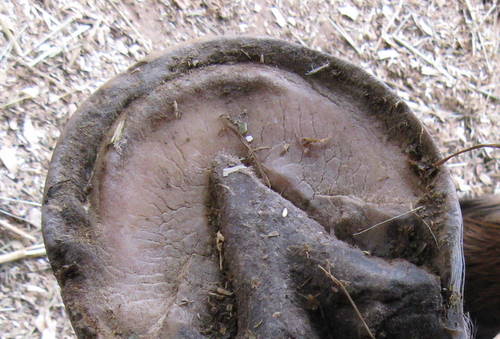
|
| Moderator: DrO |
Posted on Thursday, Dec 17, 2009 - 6:35 pm: Hello CherylK,As everyone above notes, a thick sole "a sole callus" is a good thing and a thick healthy sole should be considered an indication a horse might do well bare foot. If shoes are put on the sole should be paired back so the inside of the shoes bars don't push on it. DrO |
| Member: scooter |
Posted on Friday, Dec 18, 2009 - 7:02 am: Dr.O. is a toe callous like Hanks above considered normal? I wonder if previously foundered horses tend to grow a bigger callous for protection. My farrier rasped Hanks down to level with his wall last year, and after the hard winter ground they disappear.Cheryl are foxes like Hanks? They are strange things! |
| Member: cheryl |
Posted on Friday, Dec 18, 2009 - 8:59 am: Thanks everyone - first - a vet is apparently out of the question - I found one who came up once and she doesn't even return my phone calls - I've tried - I suggested x-rays when she was here and she didn't think they were necessary. I had called because I thought Fox had an abscess - she dug in the foot - couldn't find one - put a drawing salve on - bandaged the foot and said it should break out in five days. After the five days she was still walking on three legs - soaked the foot in hot epsom salt water - could not find any evidence of an abscess breaking out anywhere on the foot - but she was much more comfortable - would still only walk but was not limping.Did not get pictures yesterday - we spent it trying to get the foot of slush cleared out of their pen before it freezes into a foot of ice. Will take them this morning. Dr. O - I think the reason the shoes hurt her so badly is because the farrier set them back some in an attempt to create a break over - the toe was probably pressing on the bulge. Diane - the bulge is much larger than Hank's but basically the same general appearance. Getting rid of the clover definitely helped - Boy is that stuff hard to kill. I've been reading all the posts on trimming and feeding - When this mare was 4 1/2 she was sent to WSU for two weeks - they did spinal x-rays and determined she was a probable wobbler - at my insistence they did a spinal tap that came turned out positive for EPM - after two treatments with the liquid diclauziril(sp) available in the US - Dr. Tobin from Gluck Equine Clinic told me to get the powered form from Canada. For a month I had to get a pound of powder down her every day. I managed to do it but her weight ballooned and she foundered. With the EDSS shoes and pads she recovered from the founder and for a period of two years was ridden every day on a trail over some really steep hills. Her weight was getting pretty close to acceptable levels - she was given one feeding of hay that was about 50% alfalfa - by that night she had foundered. Since then we have moved four times and her founder count in closing in on 20. I think the bulges in her feet are the result of the latest bout of founder. This is going to have to be resolved without the help of a vet or a farrier with experience dealing with foundered horses - they just don't exist here. The farrier is still wanting to put shoes back on her - not going to happen. Is it possible to tape the angled pads on and have them do any good? Right now she is apparently sound - she runs and bucks just like she's got good sense. She is probably about 100 pounds overweight. Has been receiving 11 pounds of really overmature timothy hay plus soy meal to make up for the low protein. I can't cut her feed anymore - I do give them extra hay when the temps DrOp below zero - I just started the soy meal about a week ago. |
| Member: scooter |
Posted on Friday, Dec 18, 2009 - 4:47 pm: Cheryl I know you have quite a battle with Fox, just like Hank looking at him wrong would set him off . With our new feeding regimen and getting his hooves in order (for a week anyway!) he is much easier to deal with, but still a constant battle. The toe callous Hank has is not normal I don't think, he only gets them in the winter when the ground gets hard and irregular and they grow huge. My other horses don't have them, so I wonder if it is somehow related to previous founder, a protection of the coffin bone so to speak. . With our new feeding regimen and getting his hooves in order (for a week anyway!) he is much easier to deal with, but still a constant battle. The toe callous Hank has is not normal I don't think, he only gets them in the winter when the ground gets hard and irregular and they grow huge. My other horses don't have them, so I wonder if it is somehow related to previous founder, a protection of the coffin bone so to speak. The clover experiment was a godsend for him, getting rid of that allowed him to graze much more, but still had to watch it a bit when the grass got lush after a rainfall and cool weather. I hope you are able to figure it out. As far as shoes the only way Hank could wear them was to grind down the inner rim so there was no shoe.. sole contact. If you do go to shoes do have that done it works remarkably well along with a wide web shoe. Post some pics of Foxes hooves and you can learn to trim like I am trying to 
|
| Moderator: DrO |
Posted on Friday, Dec 18, 2009 - 5:23 pm: DianeE, briefly I often see soles that look like this that are thin behind the raised area at the toe. So that we have all the history the best place to begin a new discussion about this foot is the whole discussion. Judgements should be based on more than just a image.DrO |
| Member: cheryl |
Posted on Saturday, Dec 19, 2009 - 6:13 pm: OK - finally got some pictures - I couldn't get pictures of her standing - everything is covered in ice - water and snow not to mention manure I haven't been able to clean for 5 days 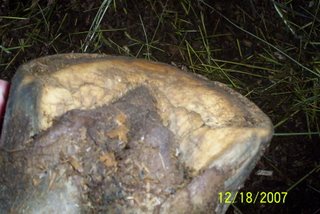 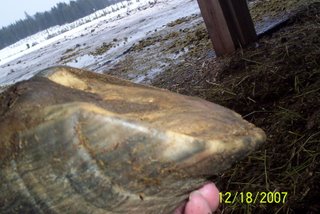 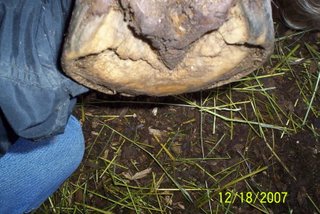 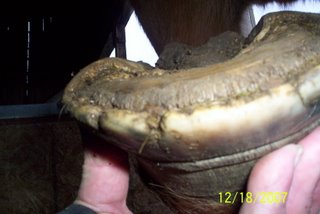 Her last trim was 11/19 - At that time he trimmed the callous down below the wall. Since he has been doing this she has been sound. No evidence of pain even walking over the gravel drive. Her last bout of founder was around May-June. I'm thinking the bulge is from rotation of the coffin bone from the founder. I've always been able to find a farrier who could put the EDSS shoes and pads on her. She has always pulled through fine. If I can get some specific information on what needs to be done to correct this I can tell the farrier. I'm totally lost here. Help please. |
| Member: scooter |
Posted on Saturday, Dec 19, 2009 - 9:00 pm: Hi Cheryl, If you are speaking of what I circled on the picture as a toe callous I'm not so sure. It reminds me very much of what Hanks hoof looked like, It appears as if this may be a stretched whiteline? He had something very similar looking as that, when the farrier rasped his toe back it would show his stretched WL like in your picture, that bothered me for a long time.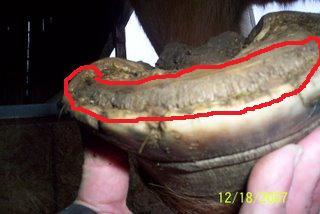 Hope Dr.O. can give you some guidance. Remember it can be done, I was just looking through Hanks hoof pictures from 2007 on and I can't believe how far he has come. I don't/ didn't have much available for farriers either, educating myself here and doing a lot of reading and a gazillion threads we are getting there finally. After looking at his pics tonight and cringing I want to put together a bunch of pictures through the last 2-3 years. Can't do it in a thread because of so many pics, but am going to make an album and post a link...it really is just short of remarkable. Hoof pics are very hard to take I think, but if you could get a little better pictures it might help. Good Luck |
| Member: cheryl |
Posted on Sunday, Dec 20, 2009 - 8:31 am: Thanks Diane. The bulge starts right at the apex of her frog - the second picture shows it best - you can also see the white line - and it is stretched. The white line shows but I think the picture you circled exaggerates it some.Nancy - is this what your horse's feet looked like? Will try to get some better pictures today - |
| Member: scooter |
Posted on Sunday, Dec 20, 2009 - 8:52 am: Cheryl you are talking about the whole sole then...not a toe callous. Hank definitely had that too after his founder, I thought maybe it was a DrOpped sole, that's why he was so hard to trim, he would end up walking on his sole if he didn't have enough wall, which led to flares and the whole mess would start over again. You can see it in some of the pictures in the link I posted.Better pictures would definitely help Is this what you are talking about? 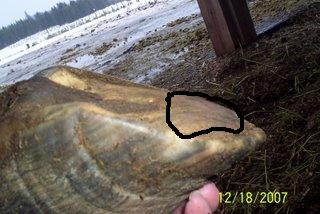
|
| Member: cheryl |
Posted on Sunday, Dec 20, 2009 - 9:25 am: That's it - so what did you do about it? I could kick myself for getting talked into moving to this place. I ask about farriers and vets before we bought it - and of course was told they are EVERYWHERE - which is true I guess - everywhere but here. I think the farrier I have now will try to do what I ask -There is no way I can tape pads on her now - and probably for the next few months - we will have frozen rock solid snow and ice until at least April - maybe longer. |
| Member: scooter |
Posted on Sunday, Dec 20, 2009 - 10:52 am: Cheryl I really don't know what we did about it, but it was one of the reasons he was so hard to trim. Seems we just kept TRYING to get his toe back and remove the flares, it really was a tough process and my farrier learned right along with me.IMHO I would not want my horse walking around on his sole, but that IS how we lived for awhile, he was very ouchy tho on any type of hard ground, and you say Fox isn't? Pads didn't help him when he was in that stage because they put pressure on his sole. which was thin to begin with. IF Dr.O. or someone can confirm that's what it is, the one thing that helped Hank stay comfortable that summer for turnout was the Davis Barrier boot. It got the sole off the ground and protected it without any undo pressure. Easy on and Easy off, not real expensive. Better pictures would be helpful, I'm not real good at knowing what to do, but there are plenty of people on here that do along with Dr.O. And of course you know to keep a strict diet and get the extra weight off if possible 
|
| Member: gwenyth |
Posted on Sunday, Dec 20, 2009 - 12:10 pm: Yes, that is what I saw in my horse that was a rotation of P3 (coffin bone). Also, I think Diane is correct that there is a lot of white line separation in that one photo (circled). This is probably due to the founder incident from May/JuneBoots are an excellent idea, I think they would help your horse. Also, have you tried feeding her Magnesium? There is anecdotal evidence that it may help horses lose weight - I had my hay analyzed and need to add the Mg and it has really helped. Do you soak your hay before you feed it? IMO - the bars are too long, and this is making the heels too high, thus the frog does not seem to be large enough and probably makes no contact with the ground. The frog should look more like Hank's in that picture above. Advice: go to www.blue-heron-farm.com/hoofmaiden and look at the photos and her qualifications and see if you agree with her methods. If you do, email her and ask her if she would look at your photos and give advice/ suggestions for a consultation fee. I DrOve 5 hours to see her a month ago and after ONE my horse is already MUCH better, and she taught me what to do so I can do it myself! She might look at your photos for free, but I suggest paying a fee - always better that way! Also, she has information about "pasture paradise" which would be a good thing for a horse that has foundered as many times as your has. Also, do you think your horse might have something else metabolic going on with it - Cushing's, EMS, IR? Also, Pete Ramey has a DVD out about rehabilitating the foundered horse - that might help your farrier - and you both. Good luck - you are in a tough situation. |
| Member: scooter |
Posted on Sunday, Dec 20, 2009 - 12:49 pm: Really Dr.O.'s articles on de-rotation are the best I have come across, we followed it best we could for Hank and it worked! More pictures in the article would be nice, but I understood most of it, and if I didn't Dr.O. and the members helped explain (hope I haven't burned them out!)Frustration isn't even close to the right word, but once I started getting an education on here it started clicking, ableit slowly! IMHO these type of hooves need TLC and the slow but sure method works better than trying to fix them overnight..Patience is one thing you will learn! Nancy is right it is a tough situation, even with a good farrier/vet team. You have to follow your own instincts sometimes. X-rays really would help quite a bit probably. |
| Member: gwenyth |
Posted on Sunday, Dec 20, 2009 - 3:37 pm: I agree that the articles on de-rotation are excellent, but since she doesn't have a barefoot farrier to help her, I thought she might want yet another option for advice as well as "horse advice".And don't be afraid to use a "real rasp" or knives! You can do it! Good luck! |
| Member: scooter |
Posted on Sunday, Dec 20, 2009 - 4:08 pm: Yes it doesn't hurt to have many options, as long as it doesn't confuse the person. It is nice to have a vet to check that advice I WOULD disagree with don't be afraid to use a "real rasp" or knives, in amateur hands and a delicate hoof, more harm than good could come of it. I also agree Cheryl can do it, but without x-rays (if indeed the many founders are the problem) even a good farrier would have problems knowing exactly where the CB is. I can not judge from Cheryls pictures how much rotation is present, how thick of sole Fox has to work with, a wrong swipe with a knife COULD lead to disaster. Just from the pictures above all we can do is guess that there MAY be significant rotation according to the stretched white line and the appearance of the sole/hoof. One picture does show a very significant line in the hoof wall. I don't think there is anything wrong with options and different opinions, as long as you know what you are dealing with, and have enough knowledge to wade through the "radical" stuff. |
| Member: gwenyth |
Posted on Sunday, Dec 20, 2009 - 6:10 pm: Sorry, it never occurred to me that it sounded like I suggested using the knives on the soles - you are correct!! I NEVER use knives on my horses soles, only on their bars and to bring the hoof wall down at the heel. Soles and hoof knives are one of those things best left to professionals - with an x-ray! And I only meant that a rasp could be used where and how she uses the other "rider's" rasp, it might be easier for her than the smaller one. I was so afraid of using them myself, and if you go carefully, you gain experience by just "doin' it." Sorry - I understand I was not clear in my explanations.Diane, You have really done well with your horses' hooves, getting him back to normal - that is really quite a journey that I am only part way through with my one horse. |
| Member: scooter |
Posted on Sunday, Dec 20, 2009 - 6:36 pm: Thanks Nancy, I just wanted to point out that it looks like Fox has a delicate foot at this time, I really can't tell, but if she does, even rasping wrong could make her sore. One reason I don't like doing Hanks hooves. Though he seems to be over any "founder problems" in his hoof it is much easier to work on him. In 2007 you couldn't have paid me to touch them!Cheryl good pics may help Dr.O. and others be able to form an opinion of sorts anyway. I hope you can get them, and Fox can be helped I know you have struggled for years with her. Determination can go a long way  Good luck |
| Moderator: DrO |
Posted on Monday, Dec 21, 2009 - 8:27 am: Cheryl,Redden believes this can be a very functional foot form and describes it as a natural result to the 4 point trim. I think your first post is right, they are forming naturally in response to the environment the horse's feet find themselves which provides no abrasion to the sole. So how well does your horse move around on the the thick robust calluses? DrO |
| Member: cheryl |
Posted on Monday, Dec 21, 2009 - 9:08 am: Thank you both very much for all your time and effort. I'm hoping Dr. O will chime in here and tell me exactly what pictures he needs to be able to get some idea of whats going on and what needs to be done.She does not appear to be tender at all right now - which is the longest she has gone between trims - I do know we need to resolve the "DrOpped sole" but have no idea how to go about it. She has been put on Thyro-l by three different vets - didn't make an ounce of difference - don't know if the magnesium would make any difference or not. Actually I think the only thing that is going to work is weight loss and the only way she looses weight is exercise. She was tested for IR and is - I had her down to 1000 - had to quit riding and she ballooned back up to 1100 - which is the weight she becomes founder prone. She still stumbles on her back feet - lands on the face of the hoof - very painful for her and scary for me - she has actually gone all the way down a couple times. Don't know if this is from the EPM or the Wobbler SynDrOme. Other than riding in circles - which I detest - there is no place around here with good footing to ride her. Thanks again - I'm hanging on every word. The farrier is due on the 31st. |
| Member: gwenyth |
Posted on Monday, Dec 21, 2009 - 10:25 am: Cheryl, if your horse is sound enough to ride, then don't overly obsess about the sole being flat. As long as your farrier continues to bring the heels down (as per Dr. O's article about de-rotation), and Dr. O agrees that the callous forms due to lack of a hard surface to wear them down, then just exercise your horse if she is sound. The more weight that comes off, the better. My horse had no response to Thyro- L, but did to the Mg, you can order a little of it and see if it helps over 2 months, and if not, then forget it. You can feed some of the supplements without needing to mix it with any grain.My farrier said that my horse needed some hoof wall above the sole to keep him comfortable, more hoof wall than she would leave on my other horses, in order that his sole not become sore from too much concussion. Maybe that is why your horse is sound long after she has been trimmed. Sometime horses can have really flat soles like yours and not necessarily from founder. Exercise - if all you have is a circle, have you ever tried ground driving? They do this at the Spanish Riding School, and I learned it from my dressage instructor. It is also called "double lunging" - you can do anything with it , walk, trot, canter, halts, lateral work at all 3 gaits, piaffe, passage, pirouettes,collection, side passes, no matter your interest, you can work on it from the ground. It will also help strengthen her - my horse with the flat soles ALSO had EPM - twice - and I used this method to get him strong again (I know what you mean about them almost falling down!). This ground work is NOT boring like regular lunging, and you can really observe your horse - this can be done in a 60' circle OR smaller. If you want some info about this, I can send you links to sites that explain it. I got 100# of my gelding this way in about 6-8 weeks. |
| Member: rtrotter |
Posted on Monday, Dec 21, 2009 - 10:54 am: For those of you that are looking for a way to exercise your horses but do not have an area to work with, you can start an area with whatever you are using for bedding and instead of taking it to the manure pile, take it to whatever the flattest, closest area that you have is and start spreading it around. It will probably take a few days to get the complete area done ( less if you have a lot of horses and do a lot of stalls) but eventually you will have a very nice area to work with. When the weather gets nicer, you can clean it up as usual, but in the meantime its a workable solution.We had a big problem with getting our horses to the track to work them, not because the track was bad but because getting to the track was treacherous, we made a path with the mucked out manure and it worked great even when it snowed, froze, thawed,refroze and snowed some more. Rachelle |
| Member: scooter |
Posted on Monday, Dec 21, 2009 - 9:53 pm: I guess I'll never figure this hoof stuff out Dr.O. are you saying that Fox's hoof looks healthy? Dr.O. are you saying that Fox's hoof looks healthy?
|
| New Member: mrgood |
Posted on Tuesday, Dec 22, 2009 - 4:28 am: I would be very grateful if you would let me share my experience on hooves looking like the above picture. I would say the main problem for this hoof is a sever infection. Often people are talking about thrush and whiteline decease as two different things but to me they are the same thing showing up in different places. In this case both the frog and the whiteline are infected. The infection in the frog impairs the protective capabilities of the frog completely. This is a much more common reason to foot soreness than sole problems. Remember that the frog is a pad and every single animal out there (except maybe our domestic horses) are walking on their pads. The impaired frog makes the horse grow higher heels to get the now unprotected nerves in the digital cushion further away from the painful contact with the ground. With higher heels the coffin bone becomes tilted, pointing toe down (like your foot in high heeled shoes) and “attacking” the sole in the toe region from the inside. This leads to a short stride and makes the horse grow a protection (toe callus) under the tip of the coffin bone. The reason the horse appears sound today is because the high heel is elevating the digital cushion away from the ground. This does however not make the horse sound but only disguise to problem.What I believe this horse needs more than anything else is a thrush treatment and a couple of days later (when an eventual soreness has decreased) get the hoof wall trimmed down to the sole level next to the hoof wall. What ever you do don’t trim sole thickness and do not trim away calluses. My recommendation for thrush treatment is soaking the hoof in about ½ pint of colloidal silver for about 5 hours. Do not expect a visible change in the hoof because of the treatment but usually you will see a difference in the horse’s movements in a couple of days and usually the sole in the back part of the hoof starts exfoliating (i.e. become soft and possible to scrape away). This is the natural way of trying to lower the heels to its natural height. A feral horse would ware down the hoof walls that is sticking out to the level of the sound frog but on a domestic horse we have to trim away the part of the hoof wall that is sticking out compared to the perimeter of the sole (like cutting your long nails to the tip of your finger). Long nails might be beautiful on human ladies but it leads to a disaster on horses. Not very many people ever have seen a perfectly healthy frog. Thrush is a very complicated condition and to defeat it is really a lifestyle issue. There is more information on thrush treatment and feeding on my website. |
| Member: scooter |
Posted on Tuesday, Dec 22, 2009 - 6:39 am: Cheryl I give up trying to figure out hooves but maybe I can help you with fox's weight. Hank has a founder weight too which is 1100#'s also, so I try to keep him at 1000#'s or less 950 seems to be a healthy weight for him and very hard to maintain, exercise or not but maybe I can help you with fox's weight. Hank has a founder weight too which is 1100#'s also, so I try to keep him at 1000#'s or less 950 seems to be a healthy weight for him and very hard to maintain, exercise or not This is not scientific, but based on my experience with a fat prone to founder horse  . . First I abide by Dr.O's obese horse article best I can, Hanks bible I call it! I do have to do my own experiments too tho. I have started letting them tell me which hay to feed them  When it comes time to buy hay I get a bale or 2 from each supplier I have available, throw a leaf of each out every night, whichever leaf they are drawn to (literally fight over) is NOT the hay I buy. The hay they leave laying to last is my choice, they are very consistent in their choices. This year surprisingly the stemmy hay was their first choice, they left this green beautiful hay to last! Surprised the heck out of me, but I know their sweet tooths don't lie so I bought the stuff that LOOKED good over the stemmy stuff. When it comes time to buy hay I get a bale or 2 from each supplier I have available, throw a leaf of each out every night, whichever leaf they are drawn to (literally fight over) is NOT the hay I buy. The hay they leave laying to last is my choice, they are very consistent in their choices. This year surprisingly the stemmy hay was their first choice, they left this green beautiful hay to last! Surprised the heck out of me, but I know their sweet tooths don't lie so I bought the stuff that LOOKED good over the stemmy stuff. This hay looks and smells good enough that I want to eat it, soft and sweet! Not so the horses  They picked well I can feed them this stuff free choice and they haven't gained an ounce and actually leave some. I guess the moral of that story is, sometimes stemmy hay can be too high in NSC's (according to my horses)The stemmy stuff this year had seed heads on it and I wonder if that was why they preferred it, don't know for sure. They picked well I can feed them this stuff free choice and they haven't gained an ounce and actually leave some. I guess the moral of that story is, sometimes stemmy hay can be too high in NSC's (according to my horses)The stemmy stuff this year had seed heads on it and I wonder if that was why they preferred it, don't know for sure. In the winter, in the past, if the horse start getting fat I skimmed the hay back. When it's cold but sunny they don't get much during the day, the sun keeps them warm, they get the majority of the hay at night when it is brutally cold. I was worried about them not having hay all the time, but my vet said would you rather have ulcers (which isn't likely) or a coffin bone go through the sole... I chose ulcers  which of course didn't happen. which of course didn't happen. They also get plenty of movement during the day in the winter, I open the big pastures once there is plenty of snow. and no ice, and let them wander and paw. I opened them up this weekend and they left their hay and went galloping over the hills...even the old mare! Hank can not have much winter grass either, he has foundered on that before so there has to be plenty of snow so he really has to work at it to get it (and he does!) If the footing is good and they are confined to the smaller pasture, I crack the whip and make the boys run around just to get the "blood flowing" the mare don't have to because she is a princesses with a bowed tendon! I am feeling ribs on him this winter (tho not skinny by any means) with this regimen, and they are able to "eat" 24/7 if they please. When we think of founder we usually just think of the front hooves, I know Hank had rotation in his back hooves also, just from the looks of them, he was trippy behind, moved funny, switched leads behind ect. (not saying this is fox's problem, just something to consider) My vet said Hank is a chronic founder and without Thro-L and some other concoction he would probably continue to founder. I thought long and hard about trying this, as he said it has helped MANY of the fat, IR horses in his practice. I did decline, hoping getting rid of the clover and letting the horses pick their hay would do it. So far this has worked (along with exercise when possible) and getting his hooves in order. He seems to always be teetering tho, and does need careful management. These are a just FEW things I have learned along the way from my fat, ir, foundered Hank. Hope there is something in there that may help you. Sorry about the long post, but I know you have struggled a long time with Fox and Know how hard and frustrating it is. Nothing is easy with these types. |
| Member: cheryl |
Posted on Tuesday, Dec 22, 2009 - 8:55 am: Dr. O - my server went down yesterday and I couldn't get back to you. When the callus gets above the hoof wall, which it is now, she doesn't move out of a walk. When they are in the back pasture, Robbers can run past her at 90 mph - and she walks. There is a lot of white line separation at the toe. I specifically ask the vet if she had thrush and the answer was no - the farrier has said no thrush also. When the callus is trimmed back below the wall she runs or paces just about everywhere she goes. The farrier is scheduled for the 31st - which will be just a tad over 8 weeks since the last trim. Are there any specific angles for pictures of the hoof that would give you a better indication of what she needs? This farrier is a young kid - trying really hard - but is in way over his head on her. I'm pretty sure he will do what I ask - I just need to know what to ask.Thanks Cheryl. |
| Moderator: DrO |
Posted on Tuesday, Dec 22, 2009 - 9:01 am: Cheryl, it appears we cross posted above so I am waiting to hear if the horse is sound.No Diane I find much wrong with the above images of the hooves but still uncertain what is going on. Reviewing the information above the one thing that would make me feel very different about the callous is if the image of the sole that Diane pulled out and circled in red IS an enlarged white line. When I looked at the picture I assumed those were rasp marks and not an enlarged white line and considered your responses to support that, particularly the horse is sound with the callous cut back. So Cheryl let's go over this again "is that the white line?". If so the callous might represent a moderately rotated coffin bone and we have a lot of work ahead of us. Good Lind, there are parts of your post I agree with and parts I disagree with. Concerning the relative amounts of problems in the sole and frog locally I see significant sole disease (bruising, abscesses) almost daily but significant frog problems (contracted, thin, with or without significant thrush) on a monthly basis. You are incorrect about WLD and thrush being the same disease. Besides some important differences in the clinical appearance it is clear that two different organisms are involved. There is one similarity and that is they both have a propensity for the white line. For more on this see: 1) Diseases of Horses » Lameness » Diseases of the Hoof » Thrush 2) Diseases of Horses » Lameness » Diseases of the Hoof » White Line Disease or Onychomycosis I do agree with your summation that the heels are long and in need of trimming and the frog looks unhealthy but am uncertain as to the severity. I would like a cleaner image to make such pronouncements. However in either case disagree that the frogs problems are causing the heel problems. Indeed I feel it would be the opposite where the long heels are resulting in contraction and an environment that might promote thrush. And I don't feel soaking will fix those long heels it is going to take a good set of nippers. I second your recommendations to not touch the sole and particularly those callouses, at least till we know what is going on with the coffin bone. In summary Cheryl, the question is not so much what to do about the callous but what is the overall health of the hooves and as you ask in one of your posts above: is there significant rotation of the coffin bone? A enlarged white line would be strong evidence but good lateral radiographs make the exact diagnosis much easier. Once documented and steps to correct it are taken many of the ills discussed above will take care of themselves. DrO |
| Member: cheryl |
Posted on Tuesday, Dec 22, 2009 - 9:44 am: Nancy - I've never done any ground driving - I don't have any equipment for it - would appreciate the sites - maybe I can figure out something with what we have here.Diane - I have read every word you have written on Hank's diets - his feet - I sprayed clover until I was blue in the face - thought I had killed off all the grass one time - our hay this year was way over mature - I don't know what the protein content is but it has to be really low - some of it was already turning brown before it was cut. I just started giving them soy meal to up their protein total - they need a good vit/min supplement - the equine nutritionist who told me to feed her free choice was WRONG - she never quit eating. Rachelle - the problem with exercise is me not them. If I had a trail close by I would ride them everyday. I absolutely hate riding in circles and because I hate it so do they. I have been throwing the manure and shavings over their main pen to give them better footing and it has helped a bunch. Their pen was pretty much cleared of ice but we are getting snow again - and after that more temps in the teens  Good Lind - thanks for all the information - there is no bad odor to her feet - She does have a bunch of white line separation form her last bout of founder but no evidence of thrush - I think the picture of the frog is mostly a bad angle shot. |
| Member: cheryl |
Posted on Tuesday, Dec 22, 2009 - 10:22 am: Dr. O1 - the photo Diane circled is red is a white line separation - I think the photo exaggerates it 2 - she is sound - I just went out to feed and she chased Robbers to the other end of the pen. The ground is frozen rock solid. 3 - I would love to get current x-rays of her feet - wanna make a farm call  I'm sure she has some rotation. She did not receive proper treatment after her last founder bout. I kept her on styrofoam pads and tried to keep her toes rasped back - which was the best I could do. I'm sure she has some rotation. She did not receive proper treatment after her last founder bout. I kept her on styrofoam pads and tried to keep her toes rasped back - which was the best I could do.
|
| New Member: mrgood |
Posted on Tuesday, Dec 22, 2009 - 12:06 pm: No disrespect but I do not agree with Dr O’s definition of thrush.We have found that thrush always starts as a fungal infection (just like white line disease) and we have found four different kinds of funguses of which a Candida is one of the most common ones. Candida is natural in the digestive system but with too high sugar intake it might spread out and become more of a systemic issue. The fungal infection is not isolated to the frog, the white line or even the hoof. It spreads with the blood to the complete organism which makes a local treatment of the frog or the hoof just a treatment of a local symptom. It has become a life style issue, just like with humans. Since fungus feeds from blood sugar this first stage of thrush does not need anything from the outside. Experience has made clear that the only way to really defeat the fungal infection is by building a healthy immune system and a very good blood circulation. The way to this healthy immune system goes through a well balanced diet that does not give high blood sugar spikes (Continuous Slow Feeding instead of portions) and of course lots of exercise. This fungal infection does not create any black slime and the smell is apparent but not the same as from the bacterial infection that often follows in the funguses foot steps if the environment is wet. I have put a video on YouTube showing this kind of fungal infections in feral mustangs living in the Nevada desert (it is easiest to view this video from www.SwedishHoofSchool.com). To the horse it doesn’t really matter if it is stage one (the fungal infection) or stage two (bacterial infection). When dissecting fungus infected frogs and frogs suffering a bacterial infection it is very obvious that both are impaired in a very similar way. Luckily for us a good soaking in colloidal silver takes care of both symptoms. Do however remember that treating the symptom does not make the patience sound. Only building a strong healthy tissue through exercise will make the frog (and white line) really sound. The treatment only makes the soreness go away so that it will be possible to exercise the frog strong and healthy. To me there is no question that this soreness coming from the frog region makes the horse grow a thicker sole in the back part of the hoof (raising the heels) since that thick sole exfoliates away as soon as the soreness is gone (2-3 days after a colloidal silver soaking). I do also have nice video sequences proving that contracted heels come from lack of frog pressure created by this kind of heel elevation. When the frog has been pacified by elevation it becomes an even easier catch for infection. A naturally low heel with a ground parallel coffin bone is essential for long time good hoof health. As you might have understood I still believe the infected frog is a major problem for this horse. I have included a picture of an almost perfect frog for reference. 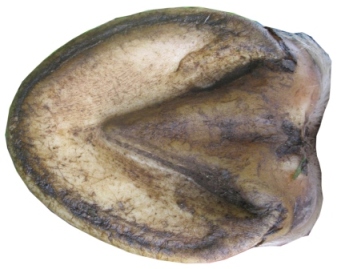
|
| Moderator: DrO |
Posted on Tuesday, Dec 22, 2009 - 6:38 pm: Cheryl, if the photo is not representative of the white line changes we are unsure of what is going on. Can you mark on the image to show us exactly what is white line. Or perhaps better is to provide some more photos. If you will take the photos using natural lighting it may help us as the flash sometimes distorts colors and relationships with the sharp shadows. Besides better images of the sole conformation shots of the feet with the horse standing square that include the pastern and lower cannon will help. If you would like to begin on reading about what lies ahead to derotate the coffin bone see Diseases of Horses » Lameness » Diseases of the Hoof » Founder & Laminitis » Rehabilitation and Derotation of Foundered Horses.Good Lind, no disrespect taken. We are here to discuss issues. Where to start with this... Let's start with the definition of thrush. My post above does not give my definition but a well established widely accepted etiology. While most of us agree the scientific study is somewhat sketchy the reason is clear: it has not been difficult to understand the problem and currently there are treatments based on this understanding that work well. In the literature you repeatedly you see stated Fusobacterium bacteria is the organism that is almost universally cultured from thrush cases. I don't remember seeing Candida as a cultured organism. But culturing alone is not enough to establish cause and effect. In the case of Fusobacterium it has been established that the organism produces keratinolytic enzymes that degrade hoof horn, giving us a mechanism for this etiology for the disease. I would also note that lately we have had several reports of good treatments using topical antibacterials that are unlikely to have much activity against funguses, indeed Candida overgrowth is often a problem where antibacterials are used. That you culture Candida is not surprising or diagnostic for the cause, you can culture hundreds of organisms commonly from healthy normal feet. The idea that thrush comes from a spreading of Candida from the digestive system to the horny tissues of the foot is counter-intuitive. Thrush starts as a superficial infection of the horn that then moves deep, as it digests horn, to the sensitive tissues. It would be the opposite with a hematogenous infection. I must say I have treated thousands of thrush cases successfully with simple local treatment and improved environmental conditions. I also have to question your assessment that this horse has painful frogs when you have not examined the horse. If the frogs have sensitive tissue exposed they may be painful but I do not see evidence of that above and have seen many hundreds (and more likely thousands) of frogs as bad as what we see in the image above without evidence of pain. DrO |
| Member: scooter |
Posted on Tuesday, Dec 22, 2009 - 8:14 pm: Cheryl you have said fox has foundered 17 or 18 times, has she really? and her last founder was this summer? If that is the case the stretched WL makes sense and possibly a "DrOpped sole", YET she is sound on hard ground? hard to figure that one out . Can they loose circulation in their hooves after so many founders Dr.O.? . Can they loose circulation in their hooves after so many founders Dr.O.? Has she ever had x-rays after her founders? From the "wrinkles" in her hoof wall it looks like she has something going on. As Dr.O. said good pictures would help him, help you  From this picture the wrinkle I circled looks kind of strange and it appears there is quite a toe dish below it, but it is hard to tell from these pictures 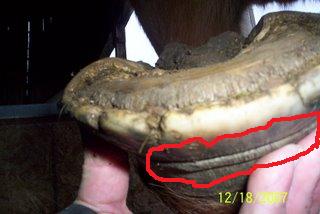
|
| Member: ajudson1 |
Posted on Tuesday, Dec 22, 2009 - 9:17 pm: A few questions:When you say she's foundered, what exactly do you mean by "foundered" Was it mechanical founder by which I mean lameness and pounding pulse due to improper hoof form, or was it founder from grain and/or rich grass overload? When I look at the pictures, I see a hoof trying to protect itself by growing a huge toe callous because the wall height at the toe is not long enough. Can you post a picture with the hoof held up or on a hoof stand, from the side, like the 2nd one, only concentrate on showing if the sole is above the wall, or below the wall at the toe. Something like this picture: (more level than this one would be nice) 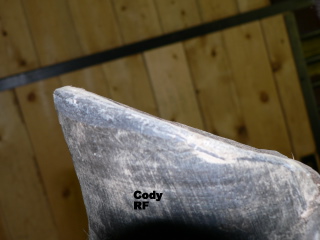
|
| Member: ajudson1 |
Posted on Tuesday, Dec 22, 2009 - 9:26 pm: I don't see much of a bevel on the toe either. You can bevel the toe without taking toe height. I had something similar going on with one of my horses this summer, he had all the signs of founder, caused by me trimming too aggressive at his toe before his sole was ready...I guess. Had some angle problems too, which you probably have with this horse.We need to see more pictures as DrO suggests. |
| Member: mrgood |
Posted on Wednesday, Dec 23, 2009 - 4:19 am: Since we ended up having a thrush discussion here (where it does not belong)I have posted my comments and questions under the thrush topic instead. |
| Member: gwenyth |
Posted on Wednesday, Dec 23, 2009 - 11:20 am: Cheryl, for ground driving, all you need is a saddle (ANY saddle) and a snaffle bit and light rope or preferably a webbed line about 40-45' in length with snaps at both ends, snaps large enough to go over the snaffle bit. You don't need a cavesson or a surcingle. Look at the article on Lunging in the newsletter:https://www.ledressage.org/April2009.pdf. There is also an excellent article in the Dec 2009 issue of "America Horse" the AQHA magazine. so ground driving is not just for dressage people. If you are an AQHA member, or know someone who is, take a look at that article. If this seems like something you might be interested in learning more about, I can send you more websites with that information.let me know if I can be of any more help. What's good about doing this with a horse with "issues" is that you can watch them move and they will tell you alot about how they feel and what they are able to do. I have an 18 yo gelding with IR who had EPM and I use this technique during the winter to keep him in shape, since I've broken my back twice and can't risk falling off again if he is "feisty" during the winter months. |
is The Horseman's Advisor
Helping Thousands of Equestrians, Farriers, and Veterinarians Every Day
All rights reserved, © 1997 -
